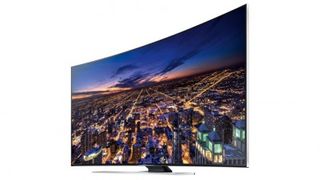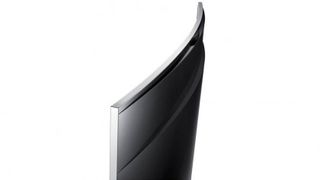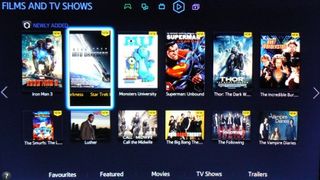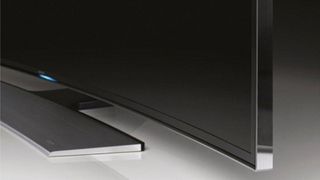TechRadar Verdict
With the UE65HU8500 Samsung has delivered its annual trick of setting a new TV benchmark for the year ahead, achieving new 4K standards while also persuasively introducing a curved LED screen for the first time.
Pros
- +
Sensational native 4K pictures
- +
Peerless 4K upscaling
- +
Upgradable connections and 'brains'
- +
Impressive audio performance
Cons
- -
Curve can exaggerate reflections
- -
Slightly high input lag
- -
3D Preset too aggressive
- -
Viewing angle limit
Why you can trust TechRadar
At the Consumer Electronic Show in Las Vegas Samsung boldly claimed that the future of TV is curved, and now it's putting its money where its mouth is by building its flagship TV series for 2014, the 4K-resolution HU8500 range, around a curved screen
On the 65-inch HU8500 model we find on our test benches the curve is very much in evidence. The screen clearly bends away from you, creating a distinctive and attractive profile that's sure to have plenty of shelf appeal in this year's TV style wars.
The curved screen and Ultra HD resolution are far from the set's only attractions, though. Also important is the compatibility of the UE65HU8500's new external connections box with the UHD-friendly HDMI 2.0 standard, the H.265 compression standard being used by Netflix for its upcoming 4K streams, and the new HDCP copyright protection system.
Plus there's a helpfully tweaked version of Samsung's renowned smart TV platform, a new QuadCore Plus processing system and a new remote which introduces 'point and click' functionality to Samsung TVs for the first time.
The UE65HU8500 arrives a few weeks ahead of upcoming new UHD/4K rivals from the likes of Sony and Panasonic, so we can't yet draw any comparisons with those models. But we'll certainly be looking for improvements over both Samsung's own F9000 UHD models from last year, as well as other stand-out UHD TVs like the Sony 65X9005A, LG 65LA970W, Toshiba 65L9363, and Panasonic L65WT600.

Design
While there are some controversial aspects to introducing curved screens to the 'flat' TV market, nobody can deny that the way the 65HU8500 curves gently backwards makes for a very attractive and distinctive design.
The frame around the curved screen is fairly, if not spectacularly, slim and quite nicely finished in gloss black. Build quality is a little more plasticky when viewed up close than you'd expected from a £4k Samsung TV, but the main thing is that its slimness leaves you feeling like the picture is the main attraction, rather than the screen that's producing it.
One point worth raising here is that, while many people may feel instantly attracted by the curved design, it's not conducive to wall hanging. The way the edges of the screen obviously curve away from the wall looks slightly awkward.

Features
There are three main strands to the 65HU8500's feature assault. First, there's the curved design we've just discussed. Second, it's got a native UHD resolution. And third, it sports Samsung's latest Smart TV system.
The first two of these are more or less self-explanatory, though we'll quickly remind you that UHD resolution is 3840x2160 pixels, leading to four times as many pixels as you get in a full HD 1920x1080 TV.
There's plenty to talk about regarding Samsung's new Smart TV platform though, even if it doesn't look all that new when you first open it up.
The opening TV hub screen is more or less identical to the one Samsung used last year, and again you can scroll across to four other hubs. But look closer and there are some substantial changes to be found.

Smart features
The most obvious one is the ditching of last year's seldom-used 'social' hub screen in favour of a Game hub, carrying links to the games available via Samsung's online portal. The social stuff (YouTube channels, Twitter etc) has been moved to the hub menu devoted to you own content (such as multimedia stored on USB sticks or networked computers).
As with last year's Samsung smart TV system, the first TV hub can be used to show recommendations culled from the TV listings, based on an analysis of your previous viewing habits.
Another hub page is built around on-demand content from a wide range of providers – including Netflix and Lovefilm/Amazon Prime. The fifth hub is essentially a Samsung's App 'store' showing you what apps you already have installed. It also provides access to many, many more you can download from Samsung's servers to the TV's built-in memory if they pique your interest.
The 65HU8500 introduces a handy and cool-looking new multi-window tool that can divide the screen into four square segments, each containing a different source. We've seen picture in picture before of course, but the possibilities opened up by having four windows rather than two are startling. Especially as you could run the internet in one while watching different sources in the others.

Football crazy
Also new for 2014 – with the World Cup in Brazil looming large – is a Football mode. This adjusts the picture settings to optimise the way the beautiful game looks onscreen. It also implements a nifty system whereby the TV can analyse crowd noise to spot game highlights that it can then automatically record to USB drive!
Elsewhere there have been some significant changes to the ways you can navigate Samsung's latest smart TV system. This includes being able to use your finger (rather than your whole hand as was the case last year) for navigating the onscreen menus.
There is a much more effective smart phone/tablet control app and a new remote control that offers point and click functionality, as well as the track pad system Samsung has supported with previous remote designs.
The UE65HU8500 has a hugely extensive suite of picture set up tools, including full colour and gamma management. It also supports local dimming from its edge LED lighting system, part of which includes Samsung's Cinema Black feature.
This controls and individually handles the lights that correspond with the black bars above and below 2.35:1-ratio films, to stop them becoming distractingly 'infected' with light bleeding from the main part of the picture.
Big brain
Samsung claims that the UE65HU8500's Quad Core Plus processing brain can work twice as fast with Smart TV functions or picture processing systems as the most powerful engine from its 2013 TV range.
This has potentially huge implications for a UHD set, given that currently such TVs have to spend the vast majority of their time using processing to upscale HD and standard definition content to the screen's UHD panel.
The extra processing power could also have profound implications on the effectiveness of other key processing elements like the local dimming system, the dynamic contrast system and the set's motion processing engine. The intriguing new processing system Samsung has developed to make sources a better fit for the screen curve will also benefit from the extra power.
You can't turn this part of the processing off, which may alarm purists, but hopefully it won't throw up any significant problems.
3D present and correct
Although it's not the core feature it once was, the UE65HU8500 still carries 3D playback, with two pairs of active shutter 3D glasses provided free with the TV.
Since this is an active 3D system, its 3D pictures will be scaled to UHD, rather than the essentially full HD resolution delivered by UHD 3D TVs that use the passive 3D system.
As with last year's Samsung UHD TVs, the UE65HU8500 ships with an external connections box. This box also contains the TV's processing brains, making it possible to upgrade to a new one in the future, allowing your TV to keep up with the latest connection and processing power developments.
In fact, people who bought one of last year's UHD TVs from Samsung will be able to replace their connections box with one of the new ones created for the HU8500 series. This gives them immediate access to things like the HDMI 2.0 ports, the H.265 compatibility and Samsung's latest Smart features.
This sort of future proofing feels more invaluable than ever before, given how fast the TV world is changing.
One last point to cover before getting stuck into the UE65HU8500's picture performance is its audio. Traditionally a weak point of Samsung's TVs, the brand has tried to improve things by equipping the set with a duct system that runs along the TV's rear and gives the speaker 'air' more room to breathe.
John has been writing about home entertainment technology for more than two decades - an especially impressive feat considering he still claims to only be 35 years old (yeah, right). In that time he’s reviewed hundreds if not thousands of TVs, projectors and speakers, and spent frankly far too long sitting by himself in a dark room.

